It’s the first day of Kindergarten. Two kids won’t stop crying, and another refuses to sit in a chair.
Writing workshop is probably the last thing on your mind! But if you’re intending to use the writing workshop model with your Kindergarteners, you’ll need to start getting things in place that first week of school.
I highly recommend using the workshop model to teach writing, even in Kindergarten. Writing workshop can help foster student independence and a love of writing – not to mention that it helps kids learn to write well!
In this post, I’ll walk you through how I plan for the writing workshop, what lessons I teach at the very beginning of the year, how I move kids from drawing to writing, and what I do to help kids stay on-task during the workshop.
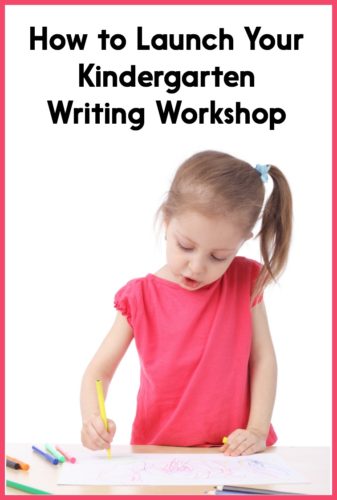
Photo Credit: lanych, Shutterstock
Plan Out Your Procedures and Expectations
Supplies
On the first day of school, it might be hard to imagine that you will eventually have a well-functioning writing workshop in your classroom. But you will – just not right away. 🙂
We need ask ourselves, “What do we want writing workshop to look like eventually?” That helps guide us in determining what routines and procedures we put in place.
The first thing I usually consider is supplies, because that affects how I set up my classroom. I want students to have easy access to pencils, crayons, paper, and tape.
In my old Kindergarten classroom, we had tables. I really liked to keep the tabletops clear, so I stored supplies on nearby shelves. When it was writing workshop time, each table leader had to bring over a supply box full of crayons and a supply box full of pencils.
We share all of our supplies, and this also makes it easier for me to see when I need to sharpen pencils, replace crayons, etc. I never wanted us to waste time on these tasks during the workshop, so I try to check and replenish the supplies after school.
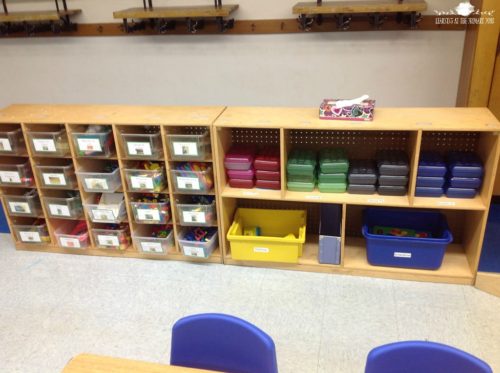
(The supplies are in the pencil boxes on the right side of the shelf – pencils are in the red boxes (1 box per table), and crayons are in the green boxes.)
I keep a bin of paper (blank paper at first, then some with lines as the year went on, and eventually little stapled booklets) in a central spot in the classroom. Kids can just go and get a new sheet of paper or writing book whenever they need to.
Regardless of how you manage supplies in your classroom, make sure kids can access them independently. When it’s writing time, you need to be freed up to confer with students, rather than constantly having to get out supplies for the kids.
Writing Folders
Speaking of supplies, I also use writing folders for having my students store their writing. I used sturdy, plastic folders with three prongs in the middle. I also kept one folder for myself, to use as a model.
I put a red sticker on one inside pocket for finished work, and a green sticker on the other side for work in progress. This helps students organize their folders and immediately find the piece that they will be working on next.
Inside the three prongs, I placed writing supports like an alphabet chart. To read more about what writing supports I use (and to get them all for FREE), check out this post.
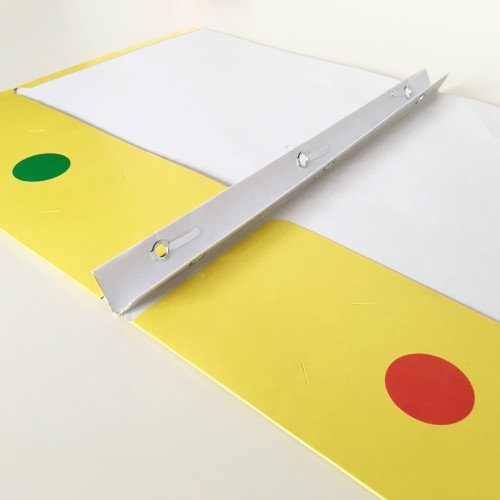
Timing
Another thing you’ll need to consider is the amount of time you’ll spend on writing workshop, as well as what that block of time will look like.
Whenever possible, I try to allot 30-45 minutes daily for writing workshop.
I definitely don’t start with such a long period of time at the beginning of the year, however!! For the first weeks of school, each minilesson only takes 3-5 minutes. Students draw and write for about 5-10 minutes, and then we have a 3-5 minute wrap-up.
Over time, I work to build students’ stamina (more on that later), so that our entire workshop takes about 40-45 minutes.
At the beginning of the year, you’ll also need to decide how much time you will spend on the minilesson, independent writing time, and sharing time.
Independent writing time should be the activity that takes up the majority of your writing workshop – this is the time when students are practicing.
Your minilesson should be between 5 and 10 minutes, and sharing time should also be about 5-10 minutes. The time “in between” is for the kids to work on their writing independently, while you confer with individual students and/or meet with small groups.
Clean-Up Signal
Before you begin the school year, decide what clean-up signal you’ll use at the end of independent writing time. You can try a bell, chimes, clapping, music, etc.
I like to start teaching kids this signal on the first or second day of school. We practice cleaning up (or pretending to clean up) at the signal before I expect them to respond to the signal without prompting.
Whole Group Routines and Expectations
Also consider what your routines and expectations will be for whole-group time (the minilesson at the beginning of the workshop and sharing time at the end).
Where will students sit? I always, always have my students sit on the rug, so they can be close to me. I make sure the rug is located near the document camera, board, and easel so that I can easily model writing and show them things. I also assign seats on the rug (though I do change up those seats throughout the year).
How will students show that they are listening? Do you expect them to be sitting criss-cross? Will their eyes need to be on you, mouths quiet? Will they need to raise their hands? I know you probably think about all these things already! But I do spend time teaching these expectations specifically as part of my writing workshop lessons at the beginning of the year.
Will students have dedicated talking and writing partners? When you say “turn and talk” during a minilesson or have students share their writing with a partner, it can be quicker if they know who they will be talking to. I also make sure to change up partnerships throughout the year.
Plan “Small Baby Steps” Lessons
The lessons at the beginning of the year can actually be super easy to plan for!
I go very slowly, teaching just one basic skill at a time (the minilessons HAVE to be short to suit their beginning-of-the-year attention spans, anyway!).
When I plan these beginning lessons, I basically assume…nothing. I expect that my Kinders will need to learn how to sit quietly, raise their hands, sit safely in chair, hold a pencil, use a crayon…you get the idea.
So I teach only one or two of these simple skills each day. I model the skill, have kids practice in some way or have a few children demonstrate (while they’re still on the rug with you), and then I have them go try it as they work independently.
Here are some examples of the beginning lessons I teach (each bullet point represents just one minilesson, and I usually teach only one minilesson per day):
- Using crayons safely
- Using pencils safely
- Storing our work in folders
- Getting more paper
- Knowing when to get more paper
- Writing our names on our work
- Organizing our folders
As you can see from this list, my writing workshop is not fully-functioning for quite a while. And I think that’s totally okay – you have to establish a solid foundation before you can “build up.”
Also, in the month of July (2016), I will be doing some free online workshops and will be sharing even more of these beginning lesson ideas, so stay tuned!
Moving from Drawing to Writing
Once you have the basics in place, only then can you start thinking about the kids’ writing!
Actually, I never expect my kids to write at the very beginning of the year. You might have some kids who are already writing, of course. But many kids will still be at that “drawing” stage.
And I think that’s totally okay! I’ve found that many of my Kinders actually need drawing instruction before they are ready to write. Many of them begin the year scribbling, using just one color, and they don’t realize that they can draw to communicate ideas.
So at the beginning of the year, my minilessons meet them where they are.
I model how to use more than one color, how I can draw using a combination of pencil and crayons, how I add details, how I draw to share my thoughts or show something that happened, etc.
Many kids will copy my drawings at first, and that’s okay. When a child draws something original, I give her tons of praise and show the other students. That helps kids get the idea that they can (and should) deviate from my example.
While we spend time working on drawing, I’m simultaneously teaching the letter sounds (at another time of the day). I’m also using an alphabet chart, so that my kids can eventually use it as a tool during writing time.
Then, about 2 weeks into the school year, I begin modeling how to label things in my pictures. I think aloud as I do so, showing students how to stretch out words to listen for their sounds. I also model how to use an alphabet chart to find the correct letters.
After multiple days of modeling, I ask kids to try it out. I often encourage them to draw some type of picture with their family members in it, and then label their family members with words like “mom,” “dad,” etc.
Some kids are resistant or stressed, and they say that they can’t do it. Rather than argue about it, I simply respond by saying something like, “What word do you want to write?” or “Let’s stretch that out together” or “What sounds do you hear?” or “Let’s use your alphabet chart to look for the first letter.” Giving them strategies is a better use of our time than simply telling them that they can do it.
I also want to mention that I never have kids copy words, sentences, or sentence frames at the beginning of the year. I’ve found that if I get in the habit of having them copy things, they will expect to ALWAYS be able to copy them. Their writing will be messy and spelled incorrectly at first, but that’s totally okay. Fostering that independence at the beginning is essential!
Similarly, I don’t tell students what to write or draw about at the beginning of the school year. I want them to get used to the idea that they are responsible for coming up with their own ideas and putting them on paper.
When we start our second unit of the school year, personal narratives, I give a little more guidance by asking them to write true stories about their lives. Even then, when I choose the genre, they still choose their own topics.
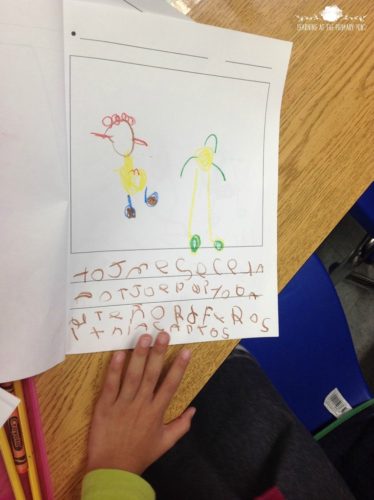
Monitor Students’ Progress and Change Your Plans Accordingly
I think one of the beautiful things about Kindergarten is that even though the first couple of weeks are astoundingly exhausting, our little ones grow and learn so quickly. Before you know it, your writing workshop will be running smoothly!
As we work up to that point, however, we have to be good “kid-watchers.” We have to pay close attention to how our students are doing with mastering the routines and procedures. We have to re-teach and re-visit lessons when necessary.
We also have to help kids build their stamina. I start off the year by providing a very, very short amount of time to draw/write (about 5 minutes). I use a timer and gradually increase that amount of time by about a minute a day (you can also graph it so students can see it, if you like).
If students are having trouble staying on task, then we go back down to 5 minutes (this is true even after weeks and weeks of school). It’s totally okay to take a step back, because it can mean that you ultimately take three steps forward.
I like to get my students invested in and excited about the amount of time we spend writing. I make a big deal of it when we reach 10 minutes for the first time, or 15. I talk about how wonderful it is that they have earned enough time to work on their writing – now they will have something great to share with a partner, or with another audience at the end of the unit.
I hope that this post was helpful to you in setting up your own writing workshop! For more guidance and complete lessons for the beginning of the school year, check out the first writing workshop unit in my Kindergarten writing series.
Happy teaching!

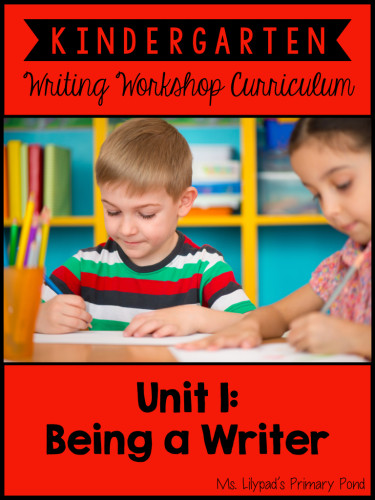

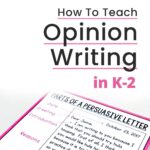
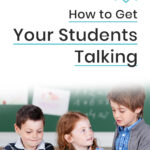
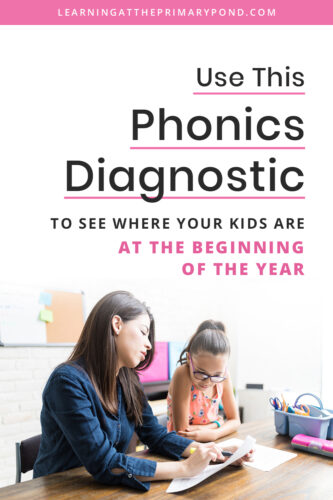

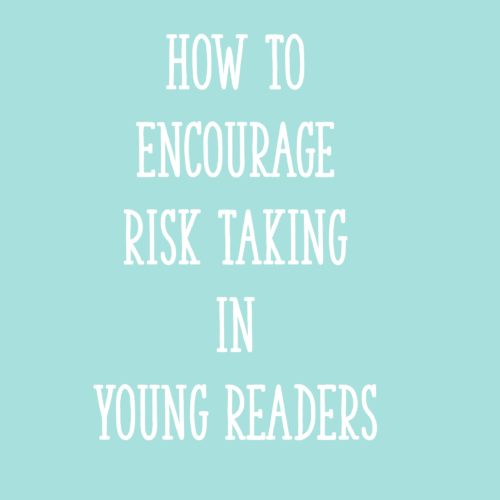






Great post. Thank you! Will your writing resources be available in Spanish anytime soon?
Hi Alma! They are on the to-do list – perhaps in about a year? 🙂
Alison
I love your ideas. I love writing and I used to teach fourth and now I teach kinder. I want to have a stronger writing program in my class and for my grade leve.
Thanks, Jennifer! That is definitely a big change from 4th to Kinder. Do you use any of my Kindergarten writing units? You can check them out here: https://www.teacherspayteachers.com/Product/Kindergarten-Writing-Workshop-Curriculum-Bundle-298852 Let me know if you have any questions!
Alison
I’m getting ready to teach my first year of kindergarten and this was really helpful! Thank you!
I’m so glad, Tara! Good luck to you in your first year! I am going to be hosting some free online workshops on teaching writing – you can look for those in about a week! 🙂
Alison
You mentioned online workshops in the beginning of July. Have you set dates for these? If so, how do I participate?
Hi Jeri! I have set dates but haven’t put up the registration link. You can check out this page for more info: https://learningattheprimarypond.com/upcoming-free-workshops-learning-primary-pond/
Hope you can join us!!
Alison
This year as a district we are pushing for more writing. I am going into my second year of teaching. This is just what i have been looking for!
I’m so glad, Anastasia! Thanks for reading and commenting 🙂
Alison
Hey! Any materials on writer’s workshop for Prek?
Hey Nicole! I don’t have anything designed specifically for PreK (I basically just had a writing center when I taught Pre-K) but you may be able to use the writing center materials for K I have coming out in September! They’ll be posted here: https://www.teacherspayteachers.com/Store/Learning-At-The-Primary-Pond-Alison
Alison